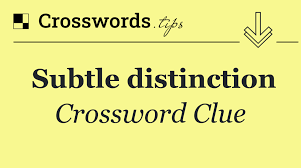What Is a Subtle Distinction?
Subtle Distinction NYT: Why the Smallest Differences Matter. A subtle distinction is a small, yet important difference. These tiny shifts in meaning, tone, or behavior can change how we think, feel, or act. The New York Times (NYT) often highlights these subtle shifts in its reporting. These differences may seem minor, but they carry weight in journalism, politics, and everyday life.

The NYT’s Style: Mastering the Subtle Distinction
The New York Times is known for its careful language. Writers often use precise words. This shows professionalism and clarity. In opinion pieces, news reports, and features, a subtle distinction in word choice can frame a topic very differently.
For example, calling a group “activists” versus “protesters” changes perception. One sounds noble. The other sounds aggressive. That’s a subtle distinction. Yet it shifts the tone of the article. The NYT is praised—and sometimes criticized—for these word choices.
Why These Distinctions Matter
In journalism, details build trust. Readers depend on accuracy and fairness. When a reporter uses a term that slightly leans one way, it can lead to bias. That’s why subtle distinctions matter so much in newsrooms.
Let’s take political coverage. If one candidate is described as “confident,” and the other as “aggressive,” the tone already influences readers. The NYT often reviews its style guide to stay neutral. But critics argue that even neutral words can carry implied meaning.
Real Examples from NYT Articles
One article on climate change used the phrase “climate crisis” rather than “climate change.” That’s a subtle distinction. But the word “crisis” adds urgency. It affects how the issue is framed.
Another example: In international news, the NYT described a group as “militants” in one story and “freedom fighters” in another. This shift can sway public opinion.
Writers at the NYT often make conscious decisions with language. The goal is to inform, not influence. But even with care, every word carries power.
Reader Response to Language Choices
Readers are more aware than ever. Social media has made it easy to discuss and challenge language choices. Some readers applaud the NYT’s subtle distinctions. They see it as thoughtful journalism.
Others say it creates hidden bias. When a reader senses slant in a news piece, trust is affected. The NYT tries to address his by publishing public editor notes and corrections when needed
The Role of Editors and Style Guides
Editors play a key role in maintaining balance. Every article is reviewed before publishing. The New York Times Stylebook offers guidelines for word usage, tone, and context. Writers follow these rules to ensure clarity.
Still, some language choices spark debate. That’s the nature of journalism. It evolves with society.
Why Your Audience Should Care
Understanding subtle distinctions helps readers become more informed. It trains the mind to think critically. In today’s fast-paced media world, where headlines often shape opinions, slowing down to notice these small differences makes a big impact.
It also helps when reading other outlets. Once you spot the tiny cues in tone or phrasing, you become a more powerful consumer of news.
Conclusion: Small Words, Big Impact
The subtle distinction NYT approach teaches us that small words matter. In a world of big headlines and bold claims, it’s often the quiet shifts that speak loudest.
The next time you read an article, pay attention to how it’s written. Are the words neutral? Are they leaning in a direction? These questions help you understand the message behind the message.
That’s the power of a subtle distinction. And that’s why it matters in journalism—and in life.


